The workshop was kindly hosted by NRG in Petten, The Netherlands.

Find the program here!
PRESENTATIONS.
Presentation of the EAN - Fernand VERMEERSCH (SCK CEN)
THEME 1 - INTERNATIONAL STANDARDS, REGULATORY AND METHODOLOGICAL GUIDANCE
International framework for the safe transport of radioactive material - Alenka BUJNOVA (IAEA)
Radiation protection of transports in France: regulatory framework and guide - Thierry CHRUPEK (ASNR) and Matthieu GUITTON (ASNR)
The organization of radioactive waste transport in Belgium and safety culture - Arno GRADE (ONDRAF)
Radiation protection and dose evaluation of workers in the transport sector in Belgium - Martine LIEBENS and Luc VERPOORTEN (FANC)
THEME 2 - CASES STUDIES
The optimization for nuclear transport at DHL - Stefan COOLS (Vincotte Controlatom)
Internal transport policy - Folkert DRAAISMA (NRG | PALLAS)
Operational aspect of on-site transport, deviations, incidents - Rohen SCHURING (NRG | PALLAS) and René STOOP (NRG | PALLAS)
THEME 3 - INCIDENTS, ACCIDENTS AND EMERGENCY RESPONSE
Progress in off-site environmental remediation in Japan - Ko TAGASAKI (Japanese Ministry of the Environment)
Optimisation in air transport of radioactive materials: a case study from Switzerland - Patrick VONLANTHEN (SFOPH)
ALARA learnings from the lost radioactive source in the Western Australian outback - Frank HARRIS (RioTinto)
Radiation protection culture: the importance of training and the benefit of the use of innovative tools - Gwenaëlle LORIOT (CEA/INSTN) and Bruno PERENNOU (Ob'dO)
RELIR/OTHEA - Transport of radioactive material used in the medical filed, occupational exposure of carriers - Pascal CROUAIL (CEPN) and Laure-Anne BOFFA-BELTRAMI (CEPN)
THEME 4 - TRANSPORT OF MEDICAL AND RADIOPHARMACEUTICAL SOURCES
Transport of radiopharmaceutical - radiation protection from start to end - Juul RIJPKEMA (CuriumPharma)
Survey of supply and transport patterns of radiopharmaceutical in the UK - Alison JONES (UKHSA) and Emma DAVIDSON (UKHSA)
Radioprotection in transport - Claude POLIART (RadioPharma) and Xavier DELCORPS (Be Sure)
Dose assessment to members of the public arising from the transport of radiopharmaceutical to Rome's hospitals - Alessandro ORSINI (ISIN)
Feedback from the Working Groups - Laura WOODWARD (UKHSA)
![]()
